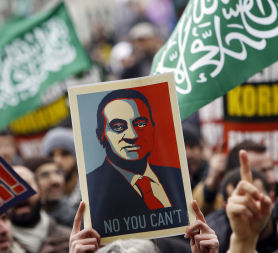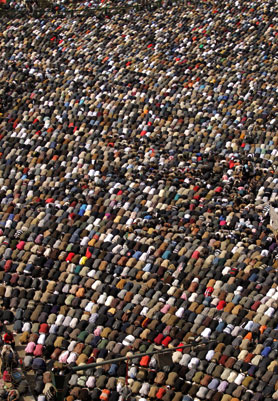Egyptians demand Mubarak exit as crowds swarm Cairo
As 200,000 Egyptians gathered in Cairo to demand President Mubarak’s removal from office, a committee of “wise men” has come up with a plan for him to cede power, reports Jonathan Rugman.
Huge crowds of Egyptians gathered in central Cairo for yet another day of mass protests after violent unrest earlier this week. Tens of thousands prayed in Cairo’s Tahrir Square amid protest banners and effigies of President Hosni Mubarak, who has ruled Egypt for the past 30 years.
After bowing for Friday prayers and listening to a cleric declare “we want the head of the regime removed”, protest chants of “Leave! Leave! Leave!” began.
Channel 4 News Foreign Affairs Correspondent Jonathan Rugman says that – while there is still a stalemate – a plan has been drawn up to allow Mubarak to cede power to his Vice President, Omar Suleiman.
These people and their President are still in a stalemate. Jonathan Rugman
“There is pressure both from American diplomats and a committee – a group of ‘wise men’ – which met both the Vice President and the Prime Minister today,” he said.
“They told us they have made an offer. They said the President can stay until September as a figurehead – that the Vice President would have all executive power – that all those in the square would not be arrested or investigated by the secret police – and that the Muslim Brotherhood would not put up a presidential candidate in September.”
But it was reported that the Vice President had not found Mubarak ready to cede power yet, he added.
Jonathan Rugman earlier witnessed thousands pouring in to central Cairo and described the scene as the “cradle of revolution”.
He said: “One man told me his mother had ordered him to stay in the square until the President had left power…These people and their President still in a stalemate.”
The mood was much calmer in the iconic centre of the Egyptian capital than in recent days, although after violence erupted earlier this week troops were dotted around the square watching the protesters.
A march to the President’s palace was earlier called off by both anti and pro-Mubarak groups.
A number of demonstrators nursed wounds from earlier fighting while others had rocks to be used against rival protesters or the “armed thugs” reported earlier this week. Pictures emerged of a number of homemade catapults which had been used to pelt rocks in the clashes between anti-government protesters and Mubarak loyalists.

Prayer ground
Many of the protesters sat down after Friday prayers to listen to a Muslim cleric, over loudspeakers, calling on people to stay together in seeking their political demands.
Helicopters hovered over the city and 10 ambulances were parked in readiness at one spot on the edge of the square, which witnessed violence on Wednesday sparked by Mubarak loyalists who charged protesters.
The protesters, from a diverse range of Egypt’s 80 million population, hope to encourage the unprecedented million-plus numbers on the streets of the nation’s cities that they saw on Tuesday.
Read more from Channel 4 News on the Arab revolt: Middle East uprisings
On that evening, Mubarak announced he would step down, but only in September, when a presidential election is due.
Mubarak says he is willing to retire but, having spent three decades portraying himself as a bulwark against radical Islam in the most populous Arab state, he has warned of “chaos” if he goes now.
Deaths
Estimates have suggested that more than 300 people have died in clashes across Egypt, which began last week and was inspired by the revolt in Tunisia which forced President Zine al-Abidine Ben Ali to flee.
In Cairo, makeshift field hospitals have been set up to deal with the rising number of severely injured people.
An online document has emerged appearing to show names, photos and the cause of death of a number of people killed during the uprising. Ages range from 16 to 60.

One of the latest victims is a young woman killed on Tuesday after being hit on the back of the head with a bat, according to the document.
Egypt’s army has reportedly been instructed to protect members of the foreign media against groups in plain clothes who have attacked and beaten journalists in the capital.
On Friday Al Jazeera Arabic said its Cairo bureau had been stormed by unknown men who destroyed the office. The news comes after the broadcaster and its journalists were subjected to repeated threats, attacks and arrests.
A number of other foreign reporters have been arrested and attacked including those working for The Guardian and The New York Times. Channel 4 News International Editor Lindsey Hilsum reported being aggressively harassed in Alexandria.
The United States and Britain have condemned a “concerted campaign” to intimidate reporters.
In Alexandria on Friday Lindsey Hilsum reported that huge numbers of anti-government and Mubarak loyalists have gathered in different parts of Egypt’s second city.
A car playing the national anthem was seen heading for a mosque where thousands gathered for another day of protest.
Read more from Channel 4 News in Egypt: 10,000 people on the streets of Alexandria
Domino effect?
In Algeria opposition groups have vowed to go ahead with a planned protest march for next week, despite promises from their president to heed some demands and allow more political freedoms.
President Abdelaziz Bouteflika, keen to stop uprisings in Egypt and Tunisia spreading to his energy-exporting state, said on Thursday he would give the opposition air time on television and soon lift a 19-year-old state of emergency.
Meanwhile in Syria, early speculation that thousands of people would turn up to spark their own so-called ‘Day of Rage’ and send a message of dissatisfaction to President Bashar al-Assad, proved over-exaggerated.
Two prominent Syrian bloggers told Channel 4 News that few, if any, protesters had turned up outside government buildings and the Internet was still up.
Abdul Haykal, a former student of School of Oriental and African Studies (SOAS) in London, now based in Damscus, said that the capital city was “Very calm, nothing is going on except for heavy rain.”
And despite a Facebook group called ‘The Syrian Revolution’ calling for protests in various cities and drawing more than 13,000 people, Syria News Wire told Channel 4 News: “Absolute silence. Nothing different from normal at all. It seems to have been hyped from outside.”
Egypt protests – photo gallery
A collection of the latest photographs from the battleground of Tahrir Square in Cairo, Egypt. Click on the image to see the gallery
